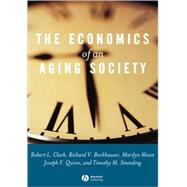
Richard V. Burkhauser is the Sarah Gibson Blanding Professor of Policy Analysis and Chair of the Department of Policy Analysis and Management in the College of Human Ecology, Cornell University.
Marilyn Moon is Vice President and Director of Health at the American Institutes for Research.
Joseph F. Quinn is Dean of the College of Arts and Sciences at Boston College.Timothy M. Smeeding is Maxwell Professor of Public Policy and Professor of Economics and Public Policy at Syracuse University.
| List of figures | ix | ||||
| List of tables | xi | ||||
| Acknowledgments | xiii | ||||
| 1 INTRODUCTION | 1 | (8) | |||
|
1 | (2) | |||
|
3 | (2) | |||
|
5 | (4) | |||
| PART I POPULATION AGING AND THE INCOME OF THE ELDERLY | 9 | (76) | |||
|
11 | (23) | |||
|
12 | (1) | |||
|
13 | (5) | |||
|
18 | (11) | |||
|
29 | (1) | |||
|
30 | (1) | |||
|
31 | (1) | |||
|
32 | (2) | |||
|
34 | (47) | |||
|
36 | (1) | |||
|
37 | (1) | |||
|
38 | (6) | |||
|
44 | (5) | |||
|
49 | (2) | |||
|
51 | (3) | |||
|
54 | (3) | |||
|
57 | (6) | |||
|
63 | (5) | |||
|
68 | (3) | |||
|
71 | (7) | |||
|
78 | (2) | |||
|
80 | (1) | |||
|
81 | (1) | |||
|
82 | (1) | |||
|
83 | (2) | |||
| PART II RETIREMENT PLANNING AND POLICIES | 85 | (82) | |||
|
81 | (30) | |||
|
89 | (1) | |||
|
89 | (4) | |||
|
93 | (5) | |||
|
98 | (6) | |||
|
104 | (4) | |||
|
108 | (1) | |||
|
109 | (1) | |||
|
109 | (1) | |||
|
110 | (1) | |||
|
111 | (24) | |||
|
112 | (1) | |||
|
112 | (5) | |||
|
117 | (8) | |||
|
125 | (3) | |||
|
128 | (1) | |||
|
129 | (3) | |||
|
132 | (1) | |||
|
132 | (1) | |||
|
133 | (1) | |||
|
133 | (2) | |||
|
135 | (34) | |||
|
137 | (1) | |||
|
137 | (1) | |||
|
138 | (7) | |||
|
145 | (3) | |||
|
148 | (1) | |||
|
148 | (3) | |||
|
151 | (3) | |||
|
154 | (2) | |||
|
156 | (4) | |||
|
160 | (1) | |||
|
160 | (4) | |||
|
164 | (3) | |||
| PART III SOCIAL SECURITY PROGRAMS AND REFORMS | 167 | (102) | |||
|
169 | (34) | |||
|
171 | (1) | |||
|
171 | (7) | |||
|
178 | (3) | |||
|
181 | (2) | |||
|
183 | (7) | |||
|
190 | (9) | |||
|
199 | (1) | |||
|
199 | (2) | |||
|
201 | (1) | |||
|
201 | (2) | |||
|
203 | (28) | |||
|
205 | (1) | |||
|
205 | (3) | |||
|
208 | (3) | |||
|
211 | (4) | |||
|
215 | (8) | |||
|
223 | (5) | |||
|
228 | (3) | |||
|
231 | (1) | |||
|
231 | (4) | |||
|
235 | ||||
|
231 | (38) | |||
|
239 | (1) | |||
|
240 | (4) | |||
|
244 | (3) | |||
|
247 | (2) | |||
|
249 | (2) | |||
|
251 | (6) | |||
|
257 | (3) | |||
|
260 | (2) | |||
|
262 | (3) | |||
|
265 | (1) | |||
|
266 | (1) | |||
|
267 | (2) | |||
| PART IV HEALTH AND LONG-TERM CARE FOR OLDER PERSONS | 269 | (75) | |||
|
211 | (105) | |||
|
273 | (1) | |||
|
273 | (7) | |||
|
280 | (4) | |||
|
284 | (4) | |||
|
288 | (12) | |||
|
300 | (1) | |||
|
301 | (7) | |||
|
308 | (1) | |||
|
308 | (1) | |||
|
309 | (1) | |||
|
309 | (1) | |||
|
310 | (6) | |||
|
316 | (28) | |||
|
318 | (1) | |||
|
319 | (4) | |||
|
323 | (6) | |||
|
329 | (5) | |||
|
334 | (6) | |||
|
340 | (1) | |||
|
341 | (1) | |||
|
341 | (1) | |||
|
342 | (2) | |||
| Index | 344 |
The New copy of this book will include any supplemental materials advertised. Please check the title of the book to determine if it should include any access cards, study guides, lab manuals, CDs, etc.
The Used, Rental and eBook copies of this book are not guaranteed to include any supplemental materials. Typically, only the book itself is included. This is true even if the title states it includes any access cards, study guides, lab manuals, CDs, etc.